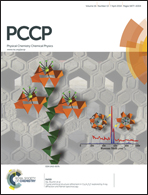Crystal structure and microstructural changes of molybdenum nitrides traced during catalytic reaction by in situ X-ray diffraction studies†
Abstract
X-ray diffraction was used to study changes in the crystal structure and microstructure of molybdenum nitrides during ammonia decomposition. In addition, electron microscopy was employed to analyse morphological changes of the nitrides caused by the catalytic reaction. Molybdenum nitride catalysts (MoxNy) were prepared via high temperature ammonolysis of molybdenum oxide (MoO3) at 650 °C and 800 °C. The materials are nanocrystalline and highly porous, the samples produced at 650 °C still contain the partly reduced precursor (MoO2). In situ X-ray diffraction studies performed on a laboratory instrument equipped with a catalysis reaction chamber reveal significant compositional and structural changes taking place during the reaction. Ball milling, known to enhance the activity of catalysts, has a deleterious effect on the molybdenum nitride specimens: it gives an initial boost due to the reduction of size and increase in dislocation content, but it also favours the formation of the less active hexagonal MoN.


 Please wait while we load your content...
Please wait while we load your content...